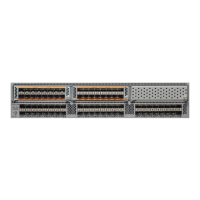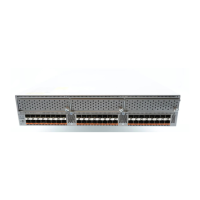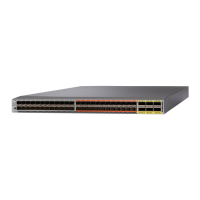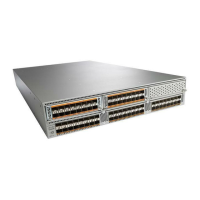Send documentation comments to n5kdocfeedback@cisco.com
1-2
Cisco Nexus 5000 Series NX-OS Interfaces Operations Guide, Release 5.0(3)N2(1)
Chapter 1 Virtual Port Channel Operations
vPC Consistency Checks
• Bypassing a vPC Consistency Check When a Peer Link is Lost, page 1-8
Type 1 and Type 2 Consistency Check Parameters
Before a Cisco Nexus 5000 Series switch brings up a vPC, the two Cisco Nexus 5000 Series switches in
the same vPC domain exchange configuration information to verify if both switches have compatible
configurations for a vPC topology. Depending on the severity of the impact of possible mismatched
configurations, some configuration parameters are considered as Type 1 consistency check parameters
while others are considered as Type 2.
When a mismatch in Type 1 parameters occur, the following applies:
• If a graceful consistency check is enabled (default), the primary switch keeps the vPC up while the
secondary switch brings it down
• If a graceful consistency check is disabled, both peer switches suspend VLANs on the vPC ports.
Note The graceful consistency check is a new feature introduced in Cisco NX-OS Release 5.0(2)N2(1) and is
enabled by default. For more details, see the “Graceful Consistency Check” section on page 1-3.
When Type 2 parameters exist, a configuration mismatch generates a warning syslog message. The vPC
on the Cisco Nexus 5000 Series switch remains up and running. The global configuration, such as
Spanning Tree Protocol (STP), and the interface-level configurations are included in the consistency
check.
The show vpc consistency-parameters global command lists all global consistency check parameters.
Beginning with Cisco NX-OS Release 5.0(2)N1(1), QoS parameters have been downgraded from Type
1 to Type 2.
This example shows how to display all global consistency check parameters:
switch# show vpc consistency-parameters global
Legend:
Type 1 : vPC will be suspended in case of mismatch
Name Type Local Value Peer Value
------------- ---- ---------------------- -----------------------
QoS 2 ([], [3], [], [], [], ([], [3], [], [], [],
[]) [])
Network QoS (MTU) 2 (1538, 2240, 0, 0, 0, (1538, 2240, 0, 0, 0,
0) 0)
Network Qos (Pause) 2 (T, F, F, F, F, F) (T, F, F, F, F, F)
Input Queuing (Bandwidth) 2 (50, 50, 0, 0, 0, 0) (50, 50, 0, 0, 0, 0)
Input Queuing (Absolute 2 (F, F, F, F, F, F) (F, F, F, F, F, F)
Priority)
Output Queuing (Bandwidth) 2 (50, 50, 0, 0, 0, 0) (50, 50, 0, 0, 0, 0)
Output Queuing (Absolute 2 (F, F, F, F, F, F) (F, F, F, F, F, F)
Priority)
STP Mode 1 MST MST
STP Disabled 1 None None
STP MST Region Name 1 "" ""
STP MST Region Revision 1 0 0
STP MST Region Instance to 1
VLAN Mapping
STP Loopguard 1 Disabled Disabled
STP Bridge Assurance 1 Enabled Enabled
STP Port Type, Edge 1 Normal, Enabled, Normal, Enabled,
BPDUFilter, Edge BPDUGuard Disabled Disabled
STP MST Simulate PVST 1 Enabled Enabled
Allowed VLANs - 1,10,100-101,200-201 1,10,100-101,200-201,2

